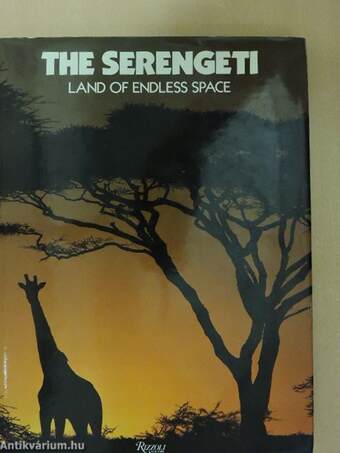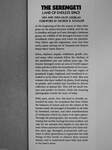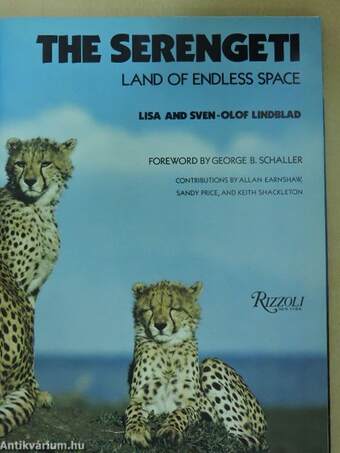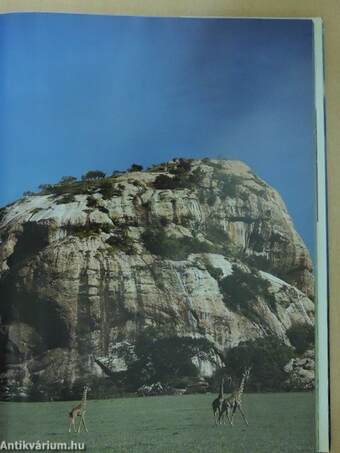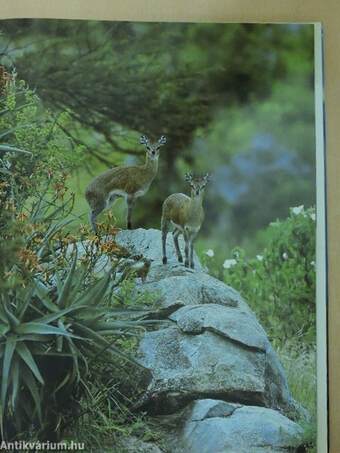1.077.004
kiadvánnyal nyújtjuk Magyarország legnagyobb antikvár könyv-kínálatát

VISSZA
A TETEJÉRE
JAVASLATOKÉszre-
vételek
The Serengeti
Land of endless space
| Kiadó: | Rizzoli International Publications, Inc. |
|---|---|
| Kiadás helye: | New York |
| Kiadás éve: | |
| Kötés típusa: | Vászon |
| Oldalszám: | 176 oldal |
| Sorozatcím: | |
| Kötetszám: | |
| Nyelv: | Angol |
| Méret: | 31 cm x 24 cm |
| ISBN: | 0-8478-1096-8 |
| Megjegyzés: | Színes fotókkal, egy térképpel. |
naponta értesítjük a beérkező friss
kiadványokról
naponta értesítjük a beérkező friss
kiadványokról
Fülszöveg
THE SERENGETI
LAND OF ENDLESS SPACE
LISA AND SVEN-OLOF LINDBLAD FOREWORD BY GEORGE B. SCHALLER
At the beginning of the diy season in May when grass on the plains becomes stubble and the sky is cloudless and pale as if seen through a luminous gauze, the wildlife of the Serengeti retreats to the woodlands where grass and water are plentifiil. They follow age-old migrations, west and then north, many moving out of Tanzania into Kenya's Masai Mara Game Reserve.
Zebra, elephant, impala, wildebeest, giraife, lion, and many other animals follow the rhythms of life established over one million years ago. The Greater Serengeti covers an area of 10,000 square miles and lies wdthin the boundaries of two countries, Kenya and Tanzania. This vast region of grassland, kopjes, highland, and woodland is revealed to us by those who know it well. Men and women who have walked its plains, lived among its people, and tracked and recorded its diverse collection of animal life. Thq^ tell the... Tovább
Fülszöveg
THE SERENGETI
LAND OF ENDLESS SPACE
LISA AND SVEN-OLOF LINDBLAD FOREWORD BY GEORGE B. SCHALLER
At the beginning of the diy season in May when grass on the plains becomes stubble and the sky is cloudless and pale as if seen through a luminous gauze, the wildlife of the Serengeti retreats to the woodlands where grass and water are plentifiil. They follow age-old migrations, west and then north, many moving out of Tanzania into Kenya's Masai Mara Game Reserve.
Zebra, elephant, impala, wildebeest, giraife, lion, and many other animals follow the rhythms of life established over one million years ago. The Greater Serengeti covers an area of 10,000 square miles and lies wdthin the boundaries of two countries, Kenya and Tanzania. This vast region of grassland, kopjes, highland, and woodland is revealed to us by those who know it well. Men and women who have walked its plains, lived among its people, and tracked and recorded its diverse collection of animal life. Thq^ tell the land's history and predict its future, while the stunning photography reveals the stoiy of today.
Wild, pure, exotic, free, this land is virtually untouched by man. An eco^stem that lives wdthin the balances of nature and not the whims of the human mind, the Serengeti is bounded on all sides by farmland, ranches, and other manifestations of civilization which lay claim to its open spaces. Through the photography, the necessity of maintaining this earthly heritage becomes evident, not only for the animals that inhabit it, but also for man whose ancestors walked here over three million years ago. Serengeti, if preserved, wall continue to allow generations to appreciate the wild things of this world, to observe their natural beauty, and to understand more fully that earth is not man's alone. Vissza
Témakörök
- Természettudomány > Növényvilág > Nemzeti parkok, arborétumok
- Idegennyelv > Idegennyelvű könyvek > Angol > Művészetek > Fotóművészet
- Idegennyelv > Idegennyelvű könyvek > Angol > Természettudományok > Földrajz
- Idegennyelv > Idegennyelvű könyvek > Angol > Természettudományok > Egyéb
- Természettudomány > Földrajz > Kontinensek földrajza > Téma szerint > Növényzet, állatvilág
- Természettudomány > Földrajz > Kontinensek földrajza > Topográfia szerint > Afrika
- Természettudomány > Földrajz > Idegen nyelv > Angol
- Művészetek > Fotóművészet > Albumok > Tematikus
- Művészetek > Fotóművészet > Idegen nyelv > Angol
- Művészetek > Fotóművészet > Témái > Élővilág
- Természettudomány > Állatvilág > Egyéb
Megvásárolható példányok
Nincs megvásárolható példány
A könyv összes megrendelhető példánya elfogyott. Ha kívánja, előjegyezheti a könyvet, és amint a könyv egy újabb példánya elérhető lesz, értesítjük.



